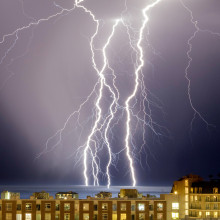How do we track lightning strikes?
Listener Derek asked us how weather presenters know about the number of lightning strikes and the process of recording them. James Tytko got in contact with the Met Office’s lightning scientist, Dr Graeme Marlton...
In this episode

- How do we know when lightning hits the Earth?
How do we know when lightning hits the Earth?
We got in contact with the Met Office’s lightning scientist, Dr Graeme Marlton.
Lightning is an electrical discharge through our atmosphere. It produces a very strong electrical current of the order of thousands of amps, and that heats up the air around it, which causes an audible sound wave to propagate outwards, which we hear as thunder. And finally, because there's a large electrical current flowing downwards that actually generates a very broadband radio transmission, and it can be detected at various parts of the radio spectrum. So one of them is the VLF between 3 and 30kHz. And one of the great things about VLF is it can propagate thousands of kilometers without becoming attenuated. So at the Met Office, we operate a lightning location system that uses this property. So a lightning strike occurs somewhere over the UK and a VLF radio wave will emanate out from the lightning strike. And we operate 10 to 11 receivers across Europe, and it'll be detected at each receiver. So we know the relative time between each receiver. And from that, we can geolocate the lightning strike. And so in practice, our lightning location system, LEELA will detect many, many lightning strikes each second, and it's able to geolocate each one and position it.










Comments
Add a comment